#the Nile
Explore tagged Tumblr posts
Text
Mythology Fact #1 - Sobek, Egyptian Crocodile God
NEW SERIES! Mythology Facts will explore many elements of world mythologies, but with a particular focus on Greek, Egyptian, and Norse, especially at the start.
Easily the winner of the first poll about this new series as held on my Patreon is Sobek, the ancient Egyptian crocodile-headed god!
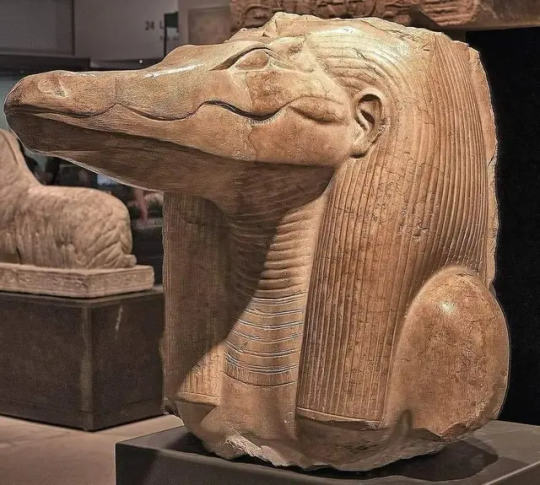
Head of a limestone statue of Sobek, as previously on display at the Met as part of a special collection; Met info on the statue head here
In ancient Egypt, like many ancient cultures, the most fearsome of beasts were highly regarded for their awe-inspiring endurance, power, and ferocity - a concept often little-understood today, as animals are now often seen as obstacles to be conquered or put out of the way, hence why it can occasionally be difficult to detail to the modern mind the relationship between men and wolves throughout history (but I'm not on that right now, so I'll stop). The people of ancient Egypt held great reverence for many animals, not least among them being the obviously very dangerous crocodile.
An integral part of life in ancient Egypt was the rise and fall of the Nile. Sobek was a centerpiece of the Nile life - crocodiles were abundant, a testament to their fertility and virility, and they were fearsome, strong, and enduring. Sobek's nature is intensely complex and his "domains," as we so often think of deities as having, were extensive, including but not limited to fertility, virility, illness, health, strength, pharonic power, military might, protection (especially protection from, essentially, bad luck), and the dangers and wonders of the Nile. By nature, he was considered animalistic, unpredictable, strong, protective but dangerous, and highly sexual, aspects frequently associated with the most powerful predators in a given region (notice all those things are also associated with wolves). Sobek was depicted variably as a crocodile and a crocodile-headed man, and holy crocodiles were kept in his name.
Given his association with the Nile and so many other things, Sobek was and mostly remained a very important figure, especially with his later fusion with/association with both Horus and Ra, two extremely important deities...
This is quite the lengthy post! More under the cut.
Among many other things, Sobek was said to have power of the fertility of the Nile's soil, as well as its waters, and thus also had great power over disease, as the Nile could also cause illnesses. Like so many ancient Egyptian deities, Sobek also had an association with the dead, being called upon to bring them sight and return their senses in the afterlife, as well as to assist in protecting them (along with many other deities, including but certainly not limited to Isis, Nephthys, and Anubis).
Sobek's strong association with fertility is found in his many epithets and even the name we use for him most - "Sobek" is thought to perhaps even come from a causative of "to impregnate" (though some scholars contend it instead means "to unite," especially in relation to the pieces of Osiris). Perhaps the first instance we have of Sobek in a text comes from the Pyramid Texts, in which a spell refers to Unis (the pharaoh) as a living incarnation of Sobek - the pharaohs were very often living incarnations of assorted deities at various times - and says that Unis "will copulate" very specifically and that he is the lord of something that would probably get this post censored, "who takes women from their husbands to the place Unis likes according to his heart's fancy."

Mummified crocodiles found in the Temple of Kom Ombo; we have found mummified crocodiles of all ages, even including fertilized eggs
Now let's talk about a thing called the petsuchos. Mummified crocodiles served as images of Sobek in various forms, one of which being Petsuchos, meaning "son of Sobek." It is thought one crocodile in particular took on the aspect of the petsuchos and was kept in Shedet, replaced by a new petsuchos whenever the previous died. Following the death of a holy crocodile, a great ritual took place to mummify the creature and then put it on display, as it remained ever sacred. Living crocodiles were sometimes kept in other temples and holy places, even including outdoor pools. They were adorned with gems and fed delicacies; some were even considered attractions, as feeding the holy crocodile brought good luck, given Sobek's apotropaic nature. There was even a divine crocodile breeding center established by Amenhotep III (who pushed the Sobek cult quite energetically).

There are many depictions of Sobek found throughout what we have of ancient Egypt, including many of its time periods. He is perhaps one of the oldest gods of ancient Egypt, having appeared as early as during the reign of King Narmer in the first dynasty. His importance during the Old Kingdom, as well, can be found in the Pyramid Texts. The entire region of Fayum was a cult center of Sobek, so great was his importance, the seat of which was - of course - the capital, Crocodilopolis or Shedet.
Also very worthy of note is Sobek-Ra, a combination of the gods Sobek and Ra, that appeared in very late-age Egypt in the New Kingdom (1150-1069 BC), and even continued into the Ptolemaic Period (around 332 BC to 390 AD). Sobek-Ra (or Sobek-Re if you want to go that way) may have first appeared during the reign of the first king of the Middle Kingdom, Montuhotep II, as addressed in the Coffin Texts used during the Middle Kingdom (in which Sobek is addressed as "he who rises in the east and sets in the west"). As a combination, depictions thereof often had the head of a falcon but the body of a crocodile, often wearing the solar disc and uraeus (cobra).
He combined aspects of both deities, which is also perhaps thanks to Sobek's association also with Horus. When Horus took on the aspect of a crocodile during his retrieval of Osiris's bodyparts, Sobek became associated with him, even considered an aspect of Horus. Likewise, however, Sobek also was said to have assisted Isis during Horus's birth. Such deity fusions, aspects, and deities becoming an aspect and/or appearing in various myths in nebulous forms were not uncommon in ancient Egypt, and Sobek was also combined with Horus at assorted other points. All of this continues to point to the association between Sobek and kings (pharaohs), especially when you reach the point of learning about Sobek of Shedet-Ra-Horus, but I won't go into all that here due to time constraints.
So, obviously, there's so much more to say that it's, frankly, crazy and almost overwhelming. The study of ancient Egypt is a complex undertaking, hence why we have an entire field called Egyptology. So, consider this very much a simplified overview. Hope you enjoyed the post!
And stay tuned for news and updates on a major [werewolf/fantasy/adventure/horror/epic] book release later this year! Likewise, if you enjoy mythology in general and Egyptian myth, be sure to check out my other works of fiction, including this one here--also available on Amazon.com and many other retailers. Sequel coming next year.
If you like my blog, be sure to follow me here and elsewhere for much more folklore and fiction, including books, especially on werewolves! You can also sign up for my free newsletter for monthly werewolf/vampire/folklore facts, a free story, book previews, and my other sundry projects and works.
Free Newsletter - maverickwerewolf.com (personal site + book shop) — Patreon — Wulfgard — Werewolf Fact Masterlist — Folklore Fact Masterlist — Mythology Fact Masterlist — X — Vampire Fact Masterlist — Amazon Author page
#mythology#myth#egyptian myth#egyptian mythology#ancient egypt#egypt#crocodile#crocodiles#the nile#nile#sobek#folklore#legend#egyptian deities#egyptian gods#mythology fact#history#egyptian history#research#fiction#Wulfgard#long post
66 notes
·
View notes
Note
Put him in the Nile
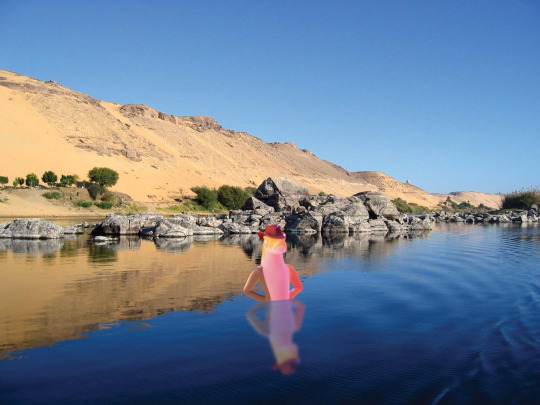
#gummigoo#gummigoo tadc#tadc#tadc ep 2#tadc episode 2#tadc gummigoo#gummy reptile somewhere#the amazing digital circus#suggested explorations#Anonymous-red-shades#the nile
63 notes
·
View notes
Text

32 notes
·
View notes
Text

The Ankh
often recognized as the Egyptian cross, in ancient Egypt it was a sysmbol of eternal life and represented the word "life" in the hieroglyphs
the shape represents the union of Isis and Osiris, bringing together male and female, sky and earth, the basis of all life.
other names it is known by: the Knot of Isis for its power to unite and bind the way Isis gathered Osiris's scattered remains to resurrect him; its significance to symbolizing eternal life also gives it the name the Key of Life; and it is also known as the Key of Nile since the annual flood in the Nile brings much fertility and life to Egypt
#art#ankh#cross#egyptian art#ancient egypt#isis goddess#osiris#life#eternal life#fertility#the nile#nile#nile valley
16 notes
·
View notes
Text









ִֶָ𐀔𓂃 ࣪˖ ִֶָde Nile 𓂃 ࣪˖ ִֶָ𐀔
#random#moodboard#death on the nile#desert#jewlery#gold jewelry#african beauty#north africa#blue eyes#culture#aesthetic#dark moodboard#mystical#mystique#brown moodboard#royalty#desert princess#so me#so me core#🌚#water#the Nile#vibes#maybe witchy#don’t come for me
16 notes
·
View notes
Text
youtube
Cairo, 1852
#cairo#egyptian pyramids#egyptology#egyptian#ancient egypt#gods of egypt#egypt#ancient city#ancient ruins#pyramids of giza#great pyramid of giza#giza#cleo de nile#nile#the nile#nile river#the mummy#the mummy returns#desert#dune#Youtube
7 notes
·
View notes
Text

Sitting by the Nile is so nice, I could keep watching the water like this forever and not get bored, it's not cold anymore here so the weather is so nice too, just a refreshing cool breeze 🥰
21 notes
·
View notes
Text
Freedom's River
She eyed the river She was musing on its duality
Years ago, they crossed the river For freedom from their enslavers
Currently, she wondered If she should leap into this river For a different "freedom"
Her being was bleeding (I am sorry….)
For her predecessors, this was the Nile For her, this might as well be the Styx
They fled from their enslavers by crossing this river And she felt like leaping into this river
She would be cursing herself Certainly, for some reasons justified
They didn't risk it all Just so she could toss herself into the river
For her, the river might as well be the Styx For them, it was the Nile, the Red Sea
They crossed this river for freedom She contemplated tossing herself into it
Fates seperate but intertwined
She was freer than them However, she was still constrained Enslaved in a different way
The Nile and the Styx She mused on this river's duality Eyeing the river still
#musings#reality subtext#written on the fly#free-verse#medium poem#revised#black history#ohio#ohio river#contemplations#death#2024 election#heartbroken#melancholy#suic1de#despair#the nile#styx#written 11/6/2024
4 notes
·
View notes
Text

Igubo killing a crocodile. In the Wilds of Africa, a Tale for Boys - 1883.
32 notes
·
View notes
Text

Palais de Gézyret, Pavillon Exterieur. Gezira, located on the Nile River in Egypt. Photo taken by Turkish photographer J. Pascal Sébah. 1870s.
The Metropolitan Museum of Art.
#J. Pascal Sébah#ottoman empire#ottoman#egyptian history#Egypt#Nile#gezira#the nile#photography#turkish history#north africa#Africa#modern history#the metropolitan
3 notes
·
View notes
Text
youtube
This is a video about people in Upper Egypt, in Nubia, who keep Nile crocodiles as pets. It's in Arabic, but the visuals are great.
11 notes
·
View notes
Text
Greco-Egyptian art and culture in Italy: the Nile Mosaic of Palestrina
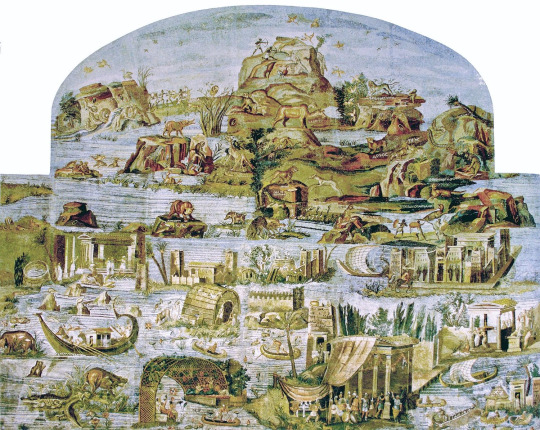
“AMONG ITS EXTRAORDINARY COLLECTION OF regional archaeology, the National Archeological Museum in Palestrina preserves a magnificent piece that stands apart from the rest: an ancient mosaic depicting a vivid scene of the flooding river Nile.
Dating to the 1st century BCE, this Egyptian mosaic is believed to be the product of Alexandrian craftsmen, and it is among the most spectacular of the late Hellenistic age. Measuring almost 20 by 13 feet (6 by 4 meters), the mosaic depicts a flooded Nilotic landscape, inhabited by animals both real and imaginary, Ptolemaic Greeks, Aethiopian hunters, and priests performing rituals in their magnificent temples. The figures are often labeled in Greek characters and the entire scene may represent a vivid map of the Nile as it flows from the highlands of Ethiopia to the delta in the Mediterranean Sea.
Archaeologists expect the mosaic was originally used as a flooring decoration for an apse in a large rectangular room built as an artificial grotto (as can be surmised from the shape of the mosaic), by the forum of the city of Praeneste. The piece has also been identified as evidence of the early spread of Egyptian cults in Italy, especially the cult of the Goddess Isis. (Certain scholars claim that Isis was already at this point being identified with Fortuna, Goddess of Praeneste.)
The mosaic’s rediscovery and preservation have been tumultuous: In the 1600s, the Barberini family removed the mosaic and took it to Rome. It was then returned to Palestrina but damaged in the process and had to be restored anew. During the Second World War, to avoid damage from the allied bombings, the mosaic was once more removed, but it is now again on display in Palestrina.
Know Before You Go
The Nile mosaic is on display on the third floor of the museum, which is open every day from 9 a.m. to 8 p.m.”
Source of the text: https://www.atlasobscura.com/places/nile-mosaic-of-palestrina
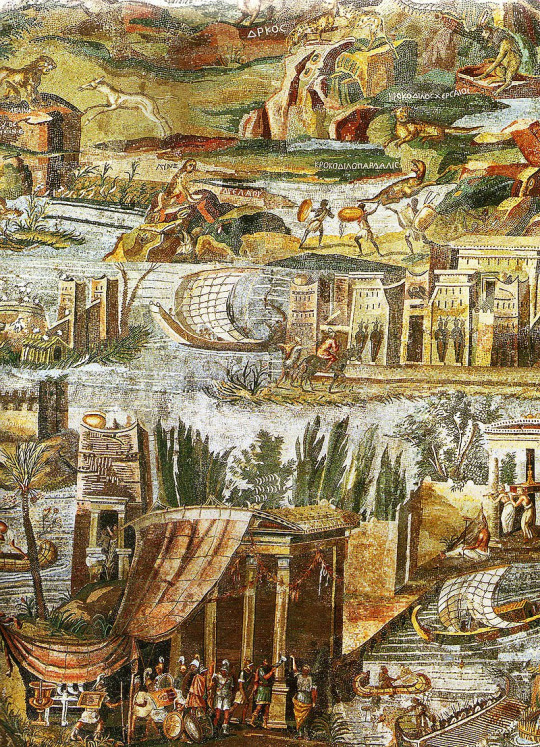

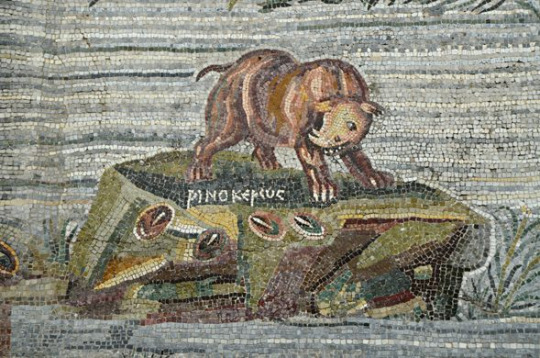
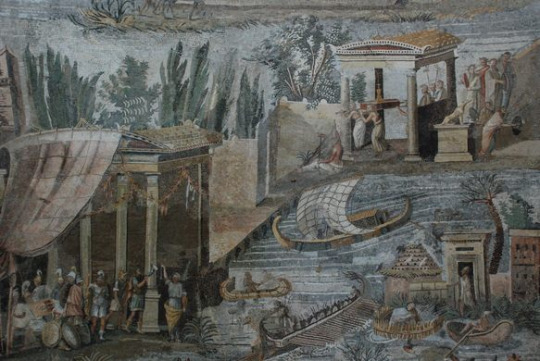
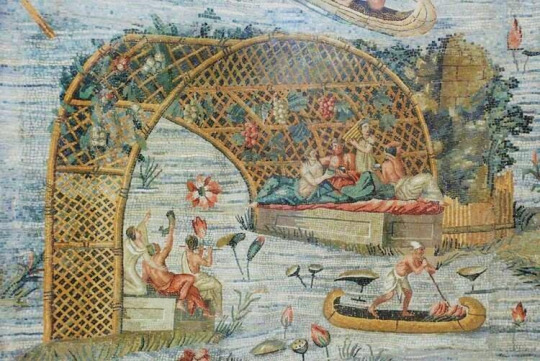

23 notes
·
View notes
Text




Happy Valentine to all explorers <3
#valentine#exploration#polar exploration#the nile#belgica#roald amundsen#david livingstone#greely#expedition#the terror#frederick cook#south pole#northpole#valentine cards
25 notes
·
View notes

